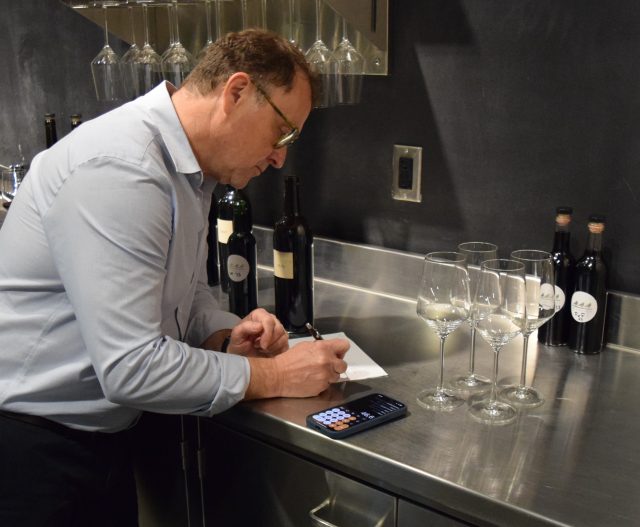This website uses cookies so that we can provide you with the best user experience possible. Cookie information is stored in your browser and performs functions such as recognising you when you return to our website and helping our team to understand which sections of the website you find most interesting and useful.
Could the ‘Boissenot Solution’ change the fate of wineries?
Can blending a few extra drops into a glass of estate wine during its assembling dramatically elevate its evolution – and perhaps even influence the fate of the winery itself? Roger Morris asks Bordeaux master blender Eric Boissenot.

When Bordeaux master blender Eric Boissenot visited his only American client, an up-and-coming winery in Virginia, this spring to help assemble its 2023
vintage, he blended a few extra drops into the glass. Call it the Boissenot 0.7% solution.
Boissenot was in familiar territory when he arrived this past April at RdV Vineyard in the rolling Virginia countryside west of Washington, D.C., to help assemble his 16th vintage of the cult winery’s estate wine as well as put together its second and third wines.
Over the two-day event, he worked with RdV’s owner and founder, Rutger de Vink, winemaker Josh Grainer and RdV’s longtime vineyard consultant, Jean-Philippe Roby. Coming in and out of the sessions were two guests whom de Vink introduced as “friends from France” – Charlotte Bouygues, whose family owns Château Montrose, Clos Rougeard and other wine estates, as well the French company’s CEO, Pierre Graffeuille.
American cru
Their addition to the party was hardly surprising, as de Vink has networked extensively in Bordeaux since he worked harvests there some years ago at Cheval Blanc and Château La Grange before starting his own winery. In fact, that was how he was introduced to Boissenot, who volunteered to help him make what de Vink considered to be “an American cru.”
The first day of blending – “We call it assemblage, as the wine is being built,” insisted Roby – was tedious yet routine, as Boissenot summarised. He first tasted the 12 lots of unblended wines – Cabernet Sauvignon, Merlot and Cabernet Franc – “in about an hour,” quickly noting his thoughts on each. From there, the four men selected four of the 12 lots to make up “the base, typically about 20% to 40% of the final blend,” he said.
“This year, the wines were very good,” Boissenot said, having periodically received samples of the evolving cuvées sent to his Bordeaux lab during the previous winter.
For the rest of the morning and most of the afternoon, the group worked on adding parts of the remaining eight cuvées back to the base. “The aim is to complement the base, to add to its complexity,” he said.
After the estate wine, labelled “Lost Mountain,” was finished, the second wine, “Rendezvous,” and the third wine, “Friends & Family,” were similarly completed. And so everyone dressed for dinner, their work completed. Or was it?
Late addition
The following morning, after a hearty American breakfast at a local resort, Boissenot reassembled the group in the winery’s small laboratory just off the barrel room. “I noted one barrel of very good press wine yesterday,” he explained, “and I think it might add to the complexity of the estate wine.” With a large sheet of paper crowded with notes, numbers and symbols by his side on the lab counter, Boissenot took down a pipette and graduated cylinder and quietly went to work.
He first carefully measured into a tasting glass a large amount of yesterday’s base blend, then added a meagre 2% of press wine to it. The four tasted and discussed the results in a mélange of English and French.
“The press wine adds a little more tension to the wine, which is good, but it takes away some of the precision and elegance of the base wine,” Boissenot decided.
He now added to a fresh glass of the base 1% – only half as much. The verdict? “It’s adding freshness, but still losing some of its finesse,” de Vink said, looking a little concerned.
Boissenot nodded with an indulgent smile. For someone with 150 clients, including most of the top-rated châteaux in Bordeaux, Boissenot quietly expresses calm and confidence without an ounce of arrogance. In appearance, he could pass for an accountant, and, in a way, he does crunch numbers that his palate provides.
Back to work, this time Boissenot added only 0.7% – seven-tenths of a single percent – the amount one might carelessly leave in the bottom of a drained glass before tasting a different wine. Suddenly, there were smiles all around. The wine was now perfect, and anyone with a decent palate could detect the differences between each minute addition made to the final blend.
Boissenot found a sun-lit table just off the visitor tasting room to make voluminous notes which he would pass along to Grainer. Later, there would be a Mexican-style cookout with all the winery’s crew, many of whom are Hispanic. Then Boissenot, Roby and the French guests would gradually make their way back to France.
Bombshell dropped
A few weeks later, in June, a surprise bombshell was dropped. Bouygues and Graffeuille had all the time been evaluating the operation before agreeing that the newly formed Eutopian Estates would purchase RdV from de Vink and rename it Lost Mountain.
“No one knew about it when they were here – not even me or Eric,” Grainer later explained. Perhaps the seven-tenths of one percent provided the final convincing.
This October, after the harvest is in, de Vink will formally say goodbye. Grainer will remain as winemaker. And Boissenot will soon begin receiving samples of his 17th American vintage in preparation for next spring’s assemblage, this time at Lost Mountain.
Related news
Playing the long game: fine wine’s global trajectory
Bordeaux Index celebrates success of The Great Wine Dinner and Auction
Will 2025 prove a 'reckoning' for the hors Bordeaux campaign?

